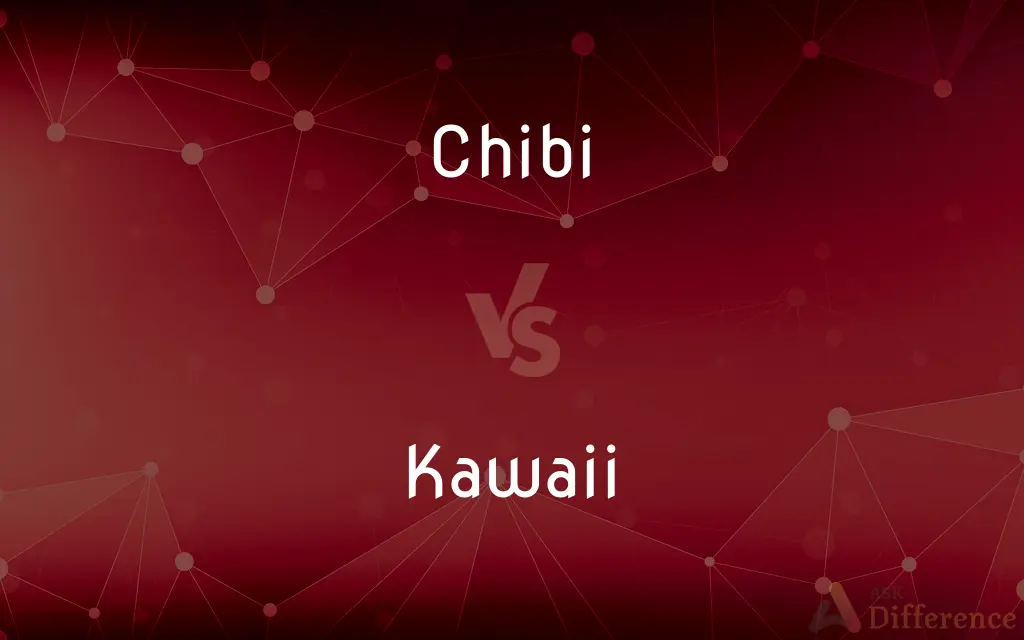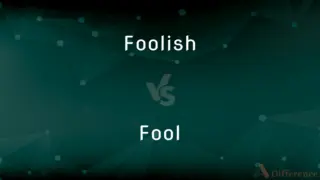Chibi vs. Kawaii — What's the Difference?
By Fiza Rafique & Maham Liaqat — Updated on March 10, 2024
Chibi refers to a specific style of caricature with exaggerated features, while kawaii denotes the broader concept of cuteness in Japanese culture.

Difference Between Chibi and Kawaii
Table of Contents
ADVERTISEMENT
Key Differences
Chibi is a Japanese slang word meaning "small" or "short," and it refers to a specific caricature style featuring characters with exaggerated features, such as large heads and eyes but small bodies, enhancing their cuteness and childlike appearance. Kawaii, on the other hand, is a Japanese term that translates to "cute" or "adorable" in English. It encompasses a wide range of elements in Japanese culture that evoke feelings of care, affection, and happiness, extending beyond visual art to fashion, behavior, and personal items.
While chibi is a distinct art style often employed in manga, anime, and various forms of merchandise to convey exaggerated cuteness or comic effect, kawaii covers a broader spectrum of cute aesthetics and is deeply ingrained in Japanese society. The kawaii culture includes everything from adorable characters and fashion styles to cute handwriting and decor. Whereas, chibi serves as one of the artistic expressions within this broader kawaii culture, focusing on a particular style of drawing characters.
Chibi characters are typically depicted with oversized heads and eyes, small bodies, and simplistic details, which emphasize their innocence and charm. This style is often used to depict humor or affection in various forms of media. Kawaii, however, is not limited to visual representation; it embodies a cultural phenomenon that influences lifestyle, fashion, art, and consumer products in Japan and globally. Kawaii items might not always adhere to the exaggerated proportions of chibi but are designed to evoke a sense of cuteness and warmth.
Both chibi and kawaii play significant roles in Japanese pop culture, but their applications and implications differ. Chibi primarily refers to a specific style within visual arts, particularly in drawing and animation, while kawaii encompasses a broader cultural and aesthetic concept. Chibi can be seen as a subset of kawaii, with its exaggerated, cute caricatures fitting well within the larger kawaii culture's emphasis on all things adorable and appealing.
Chibi characters often find their place in a variety of contexts, from comedic relief in a story to appealing avatars in video games and social media, leveraging their exaggerated cuteness to connect with audiences. Kawaii culture, in contrast, transcends visual art, influencing personal behavior, social interactions, and even business practices, with companies often incorporating kawaii elements into their branding and product design to attract consumers.
ADVERTISEMENT
Comparison Chart
Definition
A caricature style with exaggerated features, especially large heads and small bodies.
A broad concept of cuteness in Japanese culture.
Scope
Specific art style within visual arts.
Broad cultural and aesthetic concept.
Features
Oversized heads and eyes, small bodies.
Encompasses a wide range of cute aesthetics.
Cultural Role
Used for humor, affection in media.
Influences lifestyle, fashion, art, consumer products.
Representation
Visual arts, particularly manga and anime.
Extends beyond visual arts to include fashion, behavior, personal items.
Compare with Definitions
Chibi
Specific to visual arts.
Chibi art is popular in manga, anime, and merchandise.
Kawaii
A cultural phenomenon.
Kawaii has become a global trend, influencing international fashion and design.
Chibi
Exaggerated caricature style.
The chibi version of the character emphasizes its cuteness with a large head and tiny body.
Kawaii
Broad concept of cuteness.
The kawaii aesthetic can be found in everything from fashion to gadgets.
Chibi
Focus on humor and affection.
Chibi characters often appear in scenes designed to lighten the mood.
Kawaii
Embraces a wide range of cute aesthetics.
From pastel colors to adorable animal motifs, kawaii encompasses diverse elements.
Chibi
Emphasizes cuteness through proportions.
The disproportionate size of the head and eyes in chibi art makes characters more adorable.
Kawaii
Influences various aspects of culture.
Kawaii culture has reshaped marketing, with companies adopting cute mascots.
Chibi
Childlike and innocent appeal.
Chibi designs simplify characters to their most endearing traits.
Kawaii
Not limited to visual representation.
Kawaii extends to behaviors and personal style, promoting a cute lifestyle.
Chibi
A child-like character with exaggerated features, particularly in anime.
Kawaii
Kawaii (Japanese: かわいい or 可愛い, IPA: [kaɰaiꜜi]; 'lovely', 'loveable', 'cute', or 'adorable') is the culture of cuteness in Japan. It can refer to items, humans and non-humans that are charming, vulnerable, shy and childlike.
Chibi
A style of cartooning in which the characters are drawn to be very small and cute.
Kawaii
Culture|ACG}} Cute, adorable.
Kawaii
Culture}} The quality of being kawaii; cuteness.
Kawaii
Cute items, especially from Japan.
Common Curiosities
Is kawaii limited to visual arts?
No, kawaii extends beyond visuals to influence fashion, behavior, and even business practices.
What is chibi?
Chibi is a caricature style with exaggerated features like large heads and small bodies, emphasizing cuteness.
How does chibi differ from kawaii?
Chibi is a specific art style, while kawaii is a broader cultural concept of cuteness.
Can a chibi character be considered kawaii?
Yes, chibi characters are often designed to be kawaii, embodying the essence of cuteness.
Can kawaii elements be found in everyday items?
Yes, from stationery to appliances, kawaii elements are incorporated to add charm and appeal.
Is chibi art exclusive to Japan?
While originating in Japan, chibi art has gained popularity worldwide, especially among fans of manga and anime.
How has kawaii culture impacted global trends?
Kawaii culture has influenced international fashion, design, and entertainment, making cuteness a global phenomenon.
Are all anime characters drawn in chibi style?
Not all; chibi is used selectively, often for comedic effect or to highlight cuteness.
How do people express kawaii in their lifestyle?
Through fashion choices, decor, personal items, and even in social interactions, embracing the aesthetic of cuteness.
What role does kawaii play in Japanese society?
Kawaii is a significant cultural force, affecting norms, tastes, and consumer behavior in Japan.
Share Your Discovery

Previous Comparison
Insect vs. Hexapod
Next Comparison
Foolish vs. FoolAuthor Spotlight
Written by
Fiza RafiqueFiza Rafique is a skilled content writer at AskDifference.com, where she meticulously refines and enhances written pieces. Drawing from her vast editorial expertise, Fiza ensures clarity, accuracy, and precision in every article. Passionate about language, she continually seeks to elevate the quality of content for readers worldwide.
Co-written by
Maham Liaqat















































